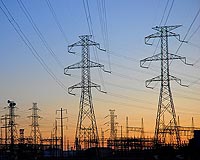 |
Boston MA (SPX) May 19, 2009 A new sponge-like material that is black, brittle and freeze-dried (just like the ice cream astronauts eat) can pull off some pretty impressive feats. Designed by Northwestern University chemists, it can remove mercury from polluted water, easily separate hydrogen from other gases and, perhaps most impressive of all, is a more effective catalyst than the one currently used to pull sulfur out of crude oil. Hydrodesulfurization might be a mouthful, but it is also a widely used catalytic chemical process that removes sulfur from natural gas and refined petroleum products, such as gasoline and diesel and jet fuels. Without the process, which is highly optimized, we'd be burning sulfur, which contributes to acid rain. Scientists have tried to improve hydrodesulfurization, or HDS, but have made no progress. Many consider it an optimized process. The Northwestern researchers, in collaboration with colleagues at Western Washington University, report that their material is twice as active as the conventional catalyst used in HDS while at the same time being made of the same parts. The material, cobalt-molybdenum-sulfur, is a new class of chalcogels, a family of material discovered only a few years ago at Northwestern. (Chalcogels are random networks of metal-sulfur atoms with very high surface areas.) The new chalcogel is made from common elements, is stable when exposed to air or water and can be used as a powder. Details of the cobalt-molybdenum-sulfur chalcogel and its properties will be published online by the journal Nature Chemistry. This is the first report of chalcogels being used for catalysis and gas separation. "I was surprised at the impressive activity of our catalyst, given how difficult it has been to improve HDS," said Mercouri G. Kanatzidis, the paper's senior author. "In principle, our catalyst could process and desulphurize twice as much crude oil as the same amount of conventional catalyst. We currently are conducting studies to see how the catalyst operates under more commercial conditions." Kanatzidis, Charles E. and Emma H. Morrison Professor of Chemistry in the Weinberg College of Arts and Sciences, and doctoral student Santanu Bag make their catalyst using a method different from that of the conventional catalyst. The Northwestern material is a gel made of cobalt, nickel, molybdenum and sulfur that then is freeze-dried, producing a sponge-like material with a very high surface area. (One cubic centimeter has approximately 10,000 square feet of surface area, or about half a football field.) It is this high surface area and the material's stability under catalytic conditions that make the cobalt-molybdenum-sulfur chalcogel so active. The researchers also demonstrated that the new chalcogel soaks up toxic heavy metals from polluted water like no other material. The chalcogel removed nearly 99 percent of the mercury from contaminated water containing several parts per million. Mercury likes to bind to sulfur, and the chalcogel is full of sulfur atoms. Two years ago, Kanatzidis and Bag reported a chalcogel that could remove mercury from liquid, but the chalcogel contained expensive platinum; the new chalcogel contains only inexpensive elements, with cobalt and nickel replacing the platinum. The cobalt and nickel link through the sulfur atoms of the thiomolybdate anions to create a three-dimensional porous network. "We succeeded in doing something very difficult: eliminating the platinum and only using common materials to create a gel," said Kanatzidis. "We found the proper conditions to get the properties we wanted. The key was changing the solvent from water to formamide." In addition to being a better HDS catalyst and a mercury sponge, the chalcogel also is very effective at gas separation. The researchers showed that the material easily removes carbon dioxide from hydrogen, an application that could be useful in the hydrogen economy. The gas separation process takes advantage of the 'soft' sulfur atoms of the chalcogel's surface. These atoms like to interact with other soft molecules passing by, slowing them down as they pass through. Hydrogen, the smallest element, is a 'hard' molecule. It zips right through while softer molecules like carbon dioxide take more time. Share This Article With Planet Earth
Related Links Northwestern University Powering The World in the 21st Century at Energy-Daily.com
 AREVA Aligns With Microsoft For Smarter Grid Solutions
AREVA Aligns With Microsoft For Smarter Grid SolutionsBethesda MD (SPX) May 18, 2009 Bethesda MD (SPX) May 18, 2009 AREVA's Transmission and Distribution (T and D) division has announced the extension of its three-year long collaboration with Microsoft to include the development of Smarter Grid Management solutions to help the worldwide power industry efficiently and reliably fulfill the future global demand for power. AREVA and Microsoft's joint efforts have already led ... read more |
|
| The content herein, unless otherwise known to be public domain, are Copyright 1995-2009 - SpaceDaily. AFP and UPI Wire Stories are copyright Agence France-Presse and United Press International. ESA Portal Reports are copyright European Space Agency. All NASA sourced material is public domain. Additional copyrights may apply in whole or part to other bona fide parties. Advertising does not imply endorsement,agreement or approval of any opinions, statements or information provided by SpaceDaily on any Web page published or hosted by SpaceDaily. Privacy Statement |